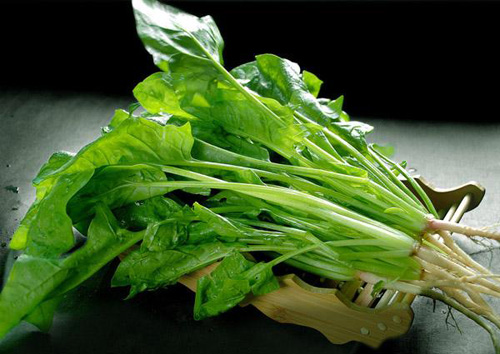VARIANT NAMES: Bolingcai, Red-Rooted Vegetable, Bosicao (Persian Grass), Yingwucai (Parrot Vegetable), Shugencai, Jiaocai.
ORIGIN: The whole grass of Spinacia oleracea [Chenopodiaceae].
CHEMICAL COMPOSITION: In every 100g of the edible part of spinach, there are 2g of protein, 0.2g of fat, 2g of carbohydrate, 70mg of calcium, 34mg of phosphorus, 2.5mg of iron, 2.96mg of carotene, 0.04mg of thiamine, 0.13 mg of ovooflavln, 0.6mg of nicotinic acid, 31mg of ascorbic acid, 0. 1g of oxalic acid, 17mg ofrutin, 1.1mg of fluorine, α-tocopherol,6-hydroxymethyl lumazin; its leaf (dried leaves), contains 56 to 68mg/kg of zinc, 1.22 /μg/g of vitamin M, amino acid, xanthophyll, β-carotene, neo-β-carotene B, neo-β-carotene U, α-spina-sterol, stigrnasten-7-ol, cholesterol, sterol ester, steroline, querce-tagetin, spinacin. The root contains spina saponin A and B.

NATURE, FLAVOR AND CHANNEL TROPISM: Sweet in flavor and cool in nature, acting on the channels of the large intestine and stomach.
EFFICIENCIES AND INDICATIONS: Nourishing the blood, arresting bleeding, astriging yin fluid, moistening dryness. It is used as a cure of Nasal Bleeding, hemafaecia, scurvy, polydipsia due to Diabetes, difficulty of feces. It has been used recently for treatment of Anemia.
DIRECTIONS: To be eaten tenderly sauted, cooked, quick-boiled in boiling water, or decocted for oral administration. Those who show symptoms of debility and loose stools should not take it.

![Diseases, Symptoms, tcm, [tcmwindow.com]](/uploadFile/adImg/2015/4/24/6de633b8-0a7a-4546-868a-02389edf5c65.png)





